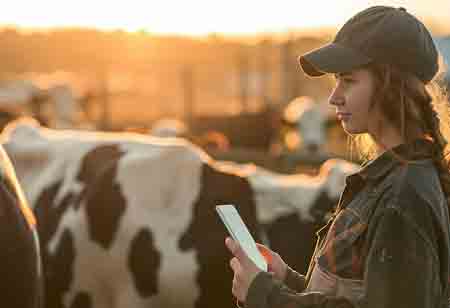Thank you for Subscribing to Agri Business Review Weekly Brief
Revolutionizing Agriculture Through Advanced Livestock Management and Monitoring
Effective livestock management and monitoring boost productivity, reduce labor costs, and enhance environmental sustainability.

By
Agri Business Review | Monday, September 15, 2025
Stay ahead of the industry with exclusive feature stories on the top companies, expert insights and the latest news delivered straight to your inbox. Subscribe today.
FREMONT, CA: Livestock management and monitoring have long been essential components of agriculture. Traditionally, farmers depended on their expertise and intuition to care for their herds. However, with recent advancements in technology—particularly in sensors and machine learning—modern tools are now playing a vital role in enhancing the efficiency and effectiveness of livestock care.
Farmers must manage and monitor their livestock herds to ensure their health and well-being. Previously, farmers managed their livestock by visual observations and manual record-keeping, which was often time-consuming and inefficient. Thanks to technological advancements, farmers can now monitor their herds in real-time and make informed management decisions. Livestock management and monitoring technology facilitate farmers to detect problems early, such as illness or damage, and take immediate action to prevent disease spread or further injury.
Additionally, monitoring technologies can assist farmers in optimizing feed and water utilization, improving reproductive performance, and increasing overall herd output.
Livestock management and monitoring technology
Sensors and machine learning algorithms are among the technological tools used in livestock management and monitoring. Among the most popular technologies for livestock management and monitoring are wearable sensors, data analytics software, and environmental sensors. Wearable sensors are used to track the health and behavior of individual animals. These sensors can monitor various characteristics, such as body temperature, heart rate, activity level, and rumination.
This information is then utilized to pinpoint potential health issues, enhance feeding and watering schedules, and improve overall herd management. Environmental sensors are used to monitor barn or pasture parameters such as temperature, humidity, and air quality. This information is utilized to improve the animals' surroundings, lowering the danger of heat stress, respiratory disorders, and other health concerns.
Data analytics software evaluates data acquired from sensors and other sources, providing farmers with information about herd health and performance. Machine learning algorithms uncover patterns and trends, helping farmers make data-driven herd management decisions.
The advantages of livestock management and monitoring technology
The application of technology in livestock management and monitoring provides numerous advantages to farmers and their herds. These advantages include better animal health and well-being, more production, lower labor costs, and greater environmental sustainability.
Livestock management and monitoring technology allow farmers to detect and address health issues early on, lowering the likelihood of disease spread and reducing the need for antibiotics. Furthermore, improving feed and water efficiency can reduce the ecological impact of livestock production, making it more sustainable in the long run. Increased production is another significant advantage of livestock management and monitoring technology. Tracking the performance of individual animals enables farmers to pinpoint areas for improvement, such as optimizing feed and water usage or enhancing reproductive performance. This approach can boost yields, enhance meat and dairy quality, and increase profitability.





